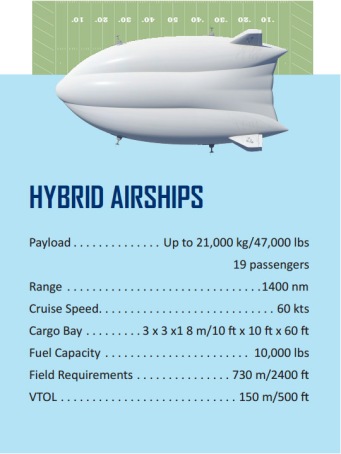During World War I, Germany was at a disadvantage in one very important aspect of warfare: its navy was severely outclassed by Britain’s. Before the war began, H.G. Wells wrote the book The War in the Air, which depicts fleets of airships acting as bombers, destroying naval fleets and cities. Germany believed in air power, and in the airship in particular. Many military planners in Germany believed the airship could even the odds in the naval arena by using airships to bomb Britain into submission. The first raid took place in 1915, ushering in an airship age that lasted until 1937 when the dirigible Hindenberg famously burst into flames in New Jersey as it approached the mooring mast after a journey across the Atlantic. While airships continued in operation, most notably as camera platforms over sporting events, their use as transport aircraft came to an end along with the Hindenberg. The public had lost confidence in them. That seems to have changed.
Why Airships? Why Now?
 The famed Skunkworks team from Lockheed Martin has spent the last decade building the first of the next generation of airships. Unlike the century-old lighter-than-air designs like the Hindenberg, these new versions are hybrid, heavier-than-air ships. Wait, what? Yes, they are heavier than air, so can’t float on their own. They rely on a combination of helium, to make it lighter, and more traditional aircraft mechanisms such as engines and wings to carry it into the sky. Because the new airships are heavier than air, they can land and stay on the ground, unlike blimps, which must have a mooring tower and can be difficult to maneuver in windy conditions. Most importantly, the new airships can get places where other cargo-carrying vehicles can’t. With two thirds of the Earth’s surface inaccessible via paved roads, and half the population living in that same two thirds, opening access via airships creates significant opportunity. Additionally, hybrid airships are very fuel efficient, making their cost of operation based on their carrying capacity low in comparison other aircraft. With resources becoming more rare, gaining easy access to previously inaccessible areas is taking on more importance.
The famed Skunkworks team from Lockheed Martin has spent the last decade building the first of the next generation of airships. Unlike the century-old lighter-than-air designs like the Hindenberg, these new versions are hybrid, heavier-than-air ships. Wait, what? Yes, they are heavier than air, so can’t float on their own. They rely on a combination of helium, to make it lighter, and more traditional aircraft mechanisms such as engines and wings to carry it into the sky. Because the new airships are heavier than air, they can land and stay on the ground, unlike blimps, which must have a mooring tower and can be difficult to maneuver in windy conditions. Most importantly, the new airships can get places where other cargo-carrying vehicles can’t. With two thirds of the Earth’s surface inaccessible via paved roads, and half the population living in that same two thirds, opening access via airships creates significant opportunity. Additionally, hybrid airships are very fuel efficient, making their cost of operation based on their carrying capacity low in comparison other aircraft. With resources becoming more rare, gaining easy access to previously inaccessible areas is taking on more importance.
Lockheed Martin Inks $480M Deal
In the first deal of its kind in modern times, Lockheed has agreed with Straightline Aviation (SLA) to deliver 12 of its new airships beginning in 2018 and finishing no later than 2021. SLA already has as many as five customers in the gas, oil and mining industries that will use the airships for cargo delivery. That the airships can deliver heavy equipment year round to remote locations dramatically lowers the cost of operations. The airships are viewed as a cross between planes, trains and trucks.
Who Else is in the Airship Game?
 A British company, Hybrid Air Vehicles, hopes to have its massive airship, the Airlander 10, flying this summer. The concept seems to be popular. In addition to the roughly $26M in earlier funding, the company recently raised £500,000 in crowdfunding in less than a day. It is about the same size as its U.S. counterpart, but carries only about half as much payload (10 metric tons vs. 20). Its test flight is imminent.
A British company, Hybrid Air Vehicles, hopes to have its massive airship, the Airlander 10, flying this summer. The concept seems to be popular. In addition to the roughly $26M in earlier funding, the company recently raised £500,000 in crowdfunding in less than a day. It is about the same size as its U.S. counterpart, but carries only about half as much payload (10 metric tons vs. 20). Its test flight is imminent.
